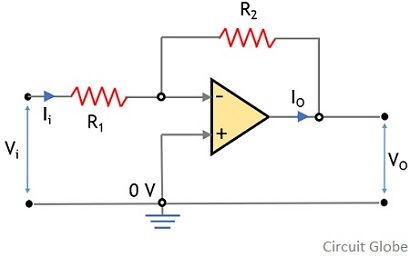The two major classifications of operational amplifiers are the inverting and non-inverting amplifier. The crucial difference between inverting and non-inverting amplifier is that an inverting amplifier is the one that produces an amplified output signal which is out of phase to the applied input. As against, a non-inverting amplifier that amplifies the input signal level without changing the phase of the signal at the output.
What is Op-amp?
Operational amplifiers are considered as the fundamental component of analog electronic circuits. It is a linear device that is used for amplification of the DC signal. Thus, is used in signal conditioning, filtering, and performing operations like addition, subtraction, integration, etc. The various components like resistor, capacitor, etc. present between the input and output terminals of the amplifier and are used for amplifying the voltage level of the applied signal.
It is a three-terminal device that has two inputs and one output terminal. Out of the two input terminals, one is an inverting terminal while the other is non-inverting.
This article will provide the idea regarding the various differentiating factors between the inverting and non-inverting amplifiers.
Content: Inverting Vs Non-Inverting Amplifier
Comparison Chart
| Basis of Comparison | Inverting Amplifier | Non-Inverting Amplifier |
|---|---|---|
| Basic | It provides an amplified signal which is out of phase with the applied input. | It is designed to provide an amplified signal which is in phase with the signal present at the input. |
| Phase difference between input and output | 180° | 0° |
| Input | Applied at negative input terminal | Provided at positive input terminal |
| Achieved output | Inverted in nature | Non-inverted in nature |
| Expressed as | Negative polarity | Positive polarity |
| Gain of Amplifier | Ratio of resistances. | Summation of 1 with the ratio of resistances. |
| Ground connection | The positive input terminal is grounded | The negative input terminal is grounded |
| Gain Polarity | Negative | Positive |
Definition of Inverting Amplifier
A type of op-amp that is designed to generate a signal at the output which is 180° out of phase with the applied input is known as an inverting amplifier. This implies that if the phase of the applied input signal is positive then the amplified signal will be in a negative phase. In a similar way for a signal with a negative phase, the phase of the output will be positive.
It is regarded as one of the simplest and widely used configurations of the op-amp. The figure below represents the circuit of inverting amplifier:
Here from the above figure, it is clear that the feedback is provided to the op-amp so as to have the closed-loop operation of the circuit. To have the accurate operation of the circuit, negative feedback is provided to it. Thus, to have a closed-loop circuit, the input, as well as the feedback signal from the output, is provided at the inverting terminal of the op-amp.
For, the above-given network, the gain is given as:![]()
Definition of Non-Inverting Amplifier
An amplifier that produces an amplified signal at the output, having a similar phase as that of the applied input is known as the non-inverting amplifier. This simply means that for an input signal with a positive phase, the output will also be positive. Also, the same goes for input with the negative phase.
The figure below represents the circuit of the non-inverting amplifier:
In this case, to have an output of the same phase as input, the input signal is applied at the non-inverting terminal of the amplifier. But here also negative feedback is to be provided, thus, the fed-back signal is provided to the inverting terminal of the op-amp. The closed-loop gain of the non-inverting amplifier is given as:
It is to be noted here that an amplifier with an inverting configuration can be converted into a non-inverting one, just be altering the provided input connections.
Key Differences Between Inverting and Non-Inverting Amplifier
- The key factor of differentiation between inverting and non-inverting amplifier is done on the basis of phase relationship existing between input and output. In the case of the inverting amplifier, the output is out of phase wrt input. Whereas for the non-inverting amplifier, both input and output are in the same phase.
- The input signal in the inverting amplifier is applied at the negative terminal of the op-amp. On the contrary, the input in the case of a non-inverting amplifier is provided at the positive terminal.
- The gain provided by the inverting amplifier is the ratio of the resistances. As against, the gain of the non-inverting amplifier is the summation of 1 and the ratio of the resistances.
- In the inverting amplifier, the non-inverting terminal is grounded. Whereas in the non-inverting amplifier, the inverting terminal of the op-amp is grounded.
- The achieved gain of the inverting amplifier is negative thus it provides inverted output. But for a non-inverting amplifier, the gain is positive and hence the achieved output is non-inverted in nature.
Conclusion
The above discussion about the inverting and non-inverting amplifier concludes that in both inverting and non-inverting amplifiers negative feedback is used that helps to provide the controllable gain of the amplifier.



this article is very helpful.